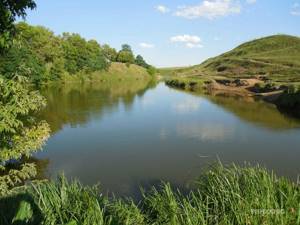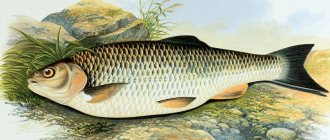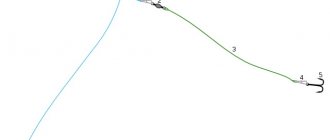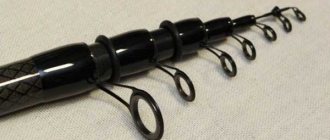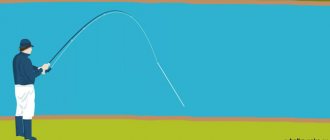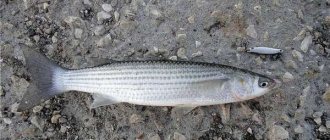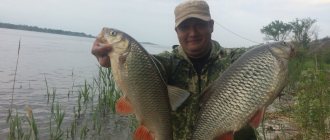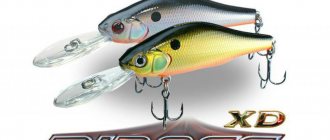General information
Grasshopper
In central Russia, grasshoppers appear, or rather, become adults, in the second half of June. If the autumn is fine, they can be found until mid-October. The species diversity of grasshoppers is amazing: even in one limited area, up to a dozen varieties are found. In more southern regions there are many chirping jumps (according to Bram) - large grasshoppers with a body length of up to 4-5 centimeters, making real flights of many meters. In flight, they open their colorful wings and even soar in the air for some time.
When catching grasshoppers, you occasionally come across large, fleshy green specimens, which are popularly called locusts or green grasshoppers. Fortunately, our geographical location has spared us the real locusts. In summer, the grasshopper is a common food for riding fish. Meadow banks with small cliffs provide her with abundant food: many imprudent horses complete their jumps by splashing down.
Once in the water, the grasshopper tries to escape by moving its legs, but these movements attract fish. There is a juicy splash, and the poor fellow ends his short life in the mouth of a chub. Fishermen a long time ago, centuries ago, noticed this interest of fish in jumping and jumping insects and use them as bait.
Methods, techniques and tactics
They hunt chub in two ways, with different equipment and different methods of delivering bait to the fishing site.
1 way. Fishing without a float on an unloaded floating rig
Review of the 10 best lures for chub
This method is used on small rivers. The basis of the gear is:
- thin hook No. 4.5;
- fishing line with a diameter of 0.12 – 0.14 mm;
- spinning rod: medium action, weight up to 10 grams, blank length 2.40 meters;
- reel with a spool capacity of 2500 according to the Shimanov classification.
Having decided on the parking areas of the intended prey, based on its exits and splashes, you should go upstream 10 - 15 meters in order to scare off the cautious fish. Casting a hook with a strung grasshopper is done in front of you, using a fishing rod or by hand. Next, the fishing line is released from the reel, and the bait is delivered by the flow of water in the river to the chub’s fattening site. The bite occurs unexpectedly, often after the bait has passed the chosen place, so you need to be alert. After the grasshopper attack:
- quickly close the reel bail;
- hook a fish that has bitten;
- Fishing should be done with constant tension on the line, preventing strong fish from leaving the hook with sudden jerks and pulls.
The main advantage of this method is camouflage and unnoticeable presentation of bait, which is the main key to successful fishing for this species of carp family.
Method 2. Fishing with a rig with a float
This method is used on rivers with a large width and strong current, as well as on reservoirs with standing water. A tuned tackle helps you make a long cast and deliver the bait to the desired point. After splashdown, a splash is produced, which with its sound scares away cautious fish for a while. To prevent such an effect, you should cast the rig upstream, 5–10 meters from the intended fishing spot, trying to carefully place the bait within the visibility range of the predator.
A long-range float allows you to deliver not only light bait with a hook, but even a small wobbler or silicone bait over a long distance.
The following equipment is used for fishing:
- spinning rod 2.70 meters long, 10 - 30 grams of dough, for long-distance casting the action of the blank is chosen to be slow;
- fishing line with a diameter of 0.14 mm;
- transparent float - water-filled, spirulino - for long-distance casting;
- hooks No. 4.5 made of thin wire;
- fluorocarbon leash with a diameter of 0.08 - 1.00 mm, a length of 0.7 - 1.2 meters.
The advantage of this method is the possibility of long casting.
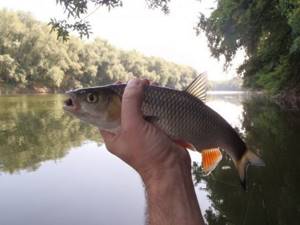
On rivers with large bodies of water, small fish are caught during the daytime. The main time for the release of trophy specimens is morning and evening dawn.
Extraction method
Not everything is as simple as it seems in reality, because the grasshoppers must first be caught. Catching a grasshopper is a gambling and exciting activity. There are nets designed for this. But if you’ve already gone fishing, then it’s clear that you don’t have anything like that with you. All that remains is the old proven method - catching a grasshopper with your own hands. However, remember that the most inconvenient places for this are fields with mown grass. It is best to catch the green jumper early in the morning, when the dew has not yet disappeared. Or in the evening, when fog descended on the ground. The fact is that these conditions contribute to dampening of the wings of grasshoppers, and this affects their mobility. The maximum that an insect can make is a small jump.
When you see a grasshopper, you just need to quickly cover it with your palm. Try to choose medium-sized individuals with a brown or gray color. It just so happens that they are easier to catch than the others. But if there are none nearby, then any will do. However, some individuals can bite, so try to catch them more carefully. It is difficult to catch grasshoppers in long grass. If you have ever caught flies, then this experience will be useful to you, since the green jumper must be brushed off the stem of your palms.
Use of artificial baits
The process of catching grasshoppers does not attract many people who are passionate about chub fishing. It is rare to catch really large grasshoppers suitable for bait. Therefore, a worthy alternative to live bait has appeared. Artificial baits that imitate a living insect are available for sale:
- silicone baits;
- wobblers;
- flies.
The advantage of such devices is their reusable use and complete imitation of an insect. There is no need to run around the meadow with a net and prepare bait. You can make flies yourself right on the pond, using available materials and information from the Internet. Sometimes, fishing with artificial bait can be more effective than fishing with a live insect. This is especially true for fishing using wobblers.
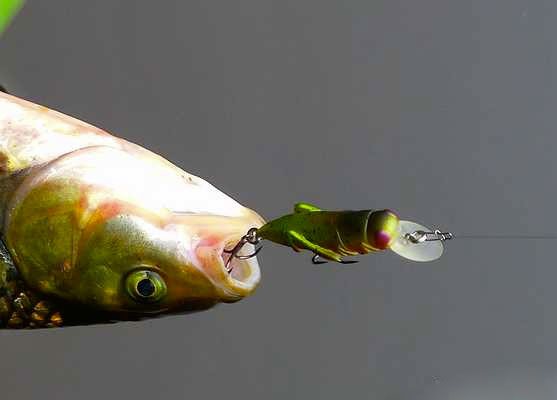
Imitation insect
Currently, the variety of plastic imitations of animal bait is quite large. You can easily choose the right size and color, but there is a drawback - sometimes this requires serious investment, which scares off many fishermen.
Storing grasshoppers
For short-term storage, when fishing is intended for one or two days, the caught grasshoppers are placed in empty, clean bottles, into which a little fresh grass is placed. The neck of the bottle is plugged with a bunch of long grass, folded so that fresh air necessarily passes between its stems. Grasshoppers harvested and placed in a bottle should not be left in the sun. On hot summer days, left in the sun even for a short time, they quickly die.
In order to preserve the stock of caught grasshoppers for a long time and well, Irkutsk fishermen make special wooden cages. In such cages with metal or plastic mesh they feel good and, warmed by the sun, chirp as if in the wild. Approximately 1/4 of its volume is filled with fresh, wet grass. During long-term storage, the grass must be moistened with fresh water through a mesh after some time.
Before the onset of autumn frosts, grasshoppers are stored for future use. To do this, they use household refrigerators, where they can remain frozen for any time, or kept alive in wooden cages for a month or more. However, all these attempts by fishermen to extend the period of catching grayling using weight flies with grasshopper bait do not give the desired effect. With the disappearance of these insects from meadows and fields, the bite on them stops and anglers begin to use other baits and lures.
How to choose a place for fishing.
Fishing for grasshoppers will be successful in shallow, not very deep bodies of water, near the shore, where sedge, reeds and other various vegetation grow. If you are going to fish on large rivers, lakes and reservoirs, the grasshopper bait should be replaced with a bait more suitable for these areas.
We suggest you read: Fishing for crucian carp with a float rod
Small reservoirs and lakes, overgrown with reeds and sedges, are the most fishing places. Reservoirs and large rivers are not suitable for these purposes.
Grasshopper fishing
Grasshopper Fishing Grasshoppers are excellent bait for catching fish. They show the best results when fly fishing. Fishing for grasshoppers with a float rod is also good. But it may happen that in the process of biting the fish bites off the legs and wings of the grasshopper, and without these parts of the body the grasshopper becomes unattractive. Therefore, the angler must keep an eye on this.
What kind of fish can you catch with a grasshopper?
These are mainly bleak, roach and perch. This bait is also used by ide, chub and asp, and generally the bite is good in the place where a lot of fish of the same species gather. Therefore, you can fully hope that you will have a strong and big fish in your hands.
Tackle for catching grasshoppers
You will need a five-meter fishing rod that has a flexible and sensitive tip. Thanks to this, you can easily throw the bait to the place you need, and also calmly figure out the area where cautious fish are biting.
As for the fishing line, this material must be selected with a thickness of no more than two millimeters, and the fishing line must be strong and rigid. It should lie on the water, as in this case it will be much easier to control the bait.
Most importantly, don't overdo it as you will spook the fish. Try to keep the line 50 centimeters higher than the rod. As for the hook, it should be small in size, have a long shank, be thin and sharp.
Since some fishermen have trouble casting a line with such a light bait as a grasshopper, very often they have to hook floats. Basically, all you need to know to successfully fish for grasshoppers is that you need a long rod, line, a hook and, of course, grasshoppers. You should not use extra weight and floats; it is better to leave these fishing accessories in your fishing bag.
Fishing technique
It is better to catch grasshoppers from the shore, which is covered with dense vegetation. Having noticed the movement of the fish, try to cast the fishing rod so that the bait hits the fish habitat that you like. Sometimes the choice of casting between water lilies will be successful. When casting a fishing rod, you should hear a whistle from the fishing line, which means you cast according to all the fishing rules. After the bait with the grasshopper reaches the surface of the water, wait a little, then begin to lead the grasshopper in any direction. As soon as you see that the fish is moving towards your bait, pause all your actions, a bite will follow almost immediately and at this moment, guided by the fishing line, hook your catch. Try not to spook the fish, especially if you have the opportunity to participate in catching chub with a grasshopper.
Catching a grasshopper will require a lot of visual strain on you, so use special sunglasses. You can store grasshoppers in various containers, the main thing is that the insect remains alive. Of course, today such fishing is not particularly used. After all, to catch fish this way, you need to chase a grasshopper across the field for bait.
Methods for hooking a grasshopper
Grasshopper on a hook No fisherman has ever succeeded in hooking a grasshopper correctly the first time, since this all comes with time - the more experience, the faster and more correctly you will succeed.
As soon as you have a couple of idle hooks, you yourself will understand your mistakes and understand how to bait grasshoppers so that the fish does not just steal the bait and swim away, but gets hooked. To do this, you can do the following.
Thread the hook through the lower part of the grasshopper's body, and try to remove the sting through the cephalothorax near the head. It is best if it remains alive, because in this form the fish will quickly pay attention to this bait. Some fishermen specially trim the legs of grasshoppers, perhaps this is more convenient for them.
It is best to catch grasshoppers that are not large or small, but medium-sized. But if you want to catch a trophy, then look for a large grasshopper.
Best time for fishing
The best time to catch fish with such bait is hot July and early August. Although in general they begin fishing with live bait in the second half of June, since during this period large grasshoppers can already be found in the meadows.
But you need to finish fishing with such bait at the end of August. With this bait, fish are better caught in the evening, from about six o'clock until sunset. At this time, without straining, you will be able to see fish walking through the water, creating circles on the water.
Weather
If you are going to fish for a grasshopper, then first of all you should know that in inclement weather it is better not to do this, as you will waste your time. Because when it rains, it is almost impossible to catch even a small fish using a grasshopper.
The best time to fish with this bait is a calm, sunny evening. At this time, midges, mosquitoes and other winged insects fly near the water. Therefore, it is on such a day that the fish are especially active and swim to the surface of the water to feast on it.
Selecting a location
Using this bait, it is better to fish in places where there are small and shallow rivers (lakes) overgrown with reeds and various vegetation. If you decide to fish on a reservoir or a large river for a grasshopper, then you can be sure that fishing will not bring you pleasure, since the bite will be bad.
How and where to catch
Places on the river where coastal bushes hang low over the water are most suitable for such fishing. I quietly walk between the thickets with a fly rod, five meters long, a 1 g float, lift the weights to the very keel, make a working descent of about 1 m, and use a fly as bait. Usually I make casts across the stream and then drag the float closer to the thickets, the wiring goes along the stream, and every two to three seconds I briefly twitch the tip of the rod. I’m not watching the fly, but the float, and then it dives sharply - a 500 gram chub suddenly grabs the bait. Such fishing is very successful near vegetation after heavy rain, thanks to which many different living creatures fall into the water; during this period, fish accumulate en masse near the bushes. Good fishing spots are also under trees overhanging the water, especially at the turns of small rivers. Ideally, if the hole in the tree has been washed out, and the current is slow and swirls with small eddies. When there is something to hide behind, a five-meter fly rod is enough to successfully throw an insect to the fish. If the shore is as bare as a falcon, I use a Bolognese fishing rod and reel, trying to cast far away and allowing the float to wander through the eddies, periodically twitching the tip of the fishing rod. It happens that in such a hole the fly begins to mercilessly fiddle with a small bleak. This does not mean at all that the place is filled only with annoying small things - large laundry can stand in the same place, but at half-water. Therefore, I always try to return the weights to their place and, having set the descent to about a meter, I fish for a lower layer of water; on the hook is still the same fly or its larva - maggot.
